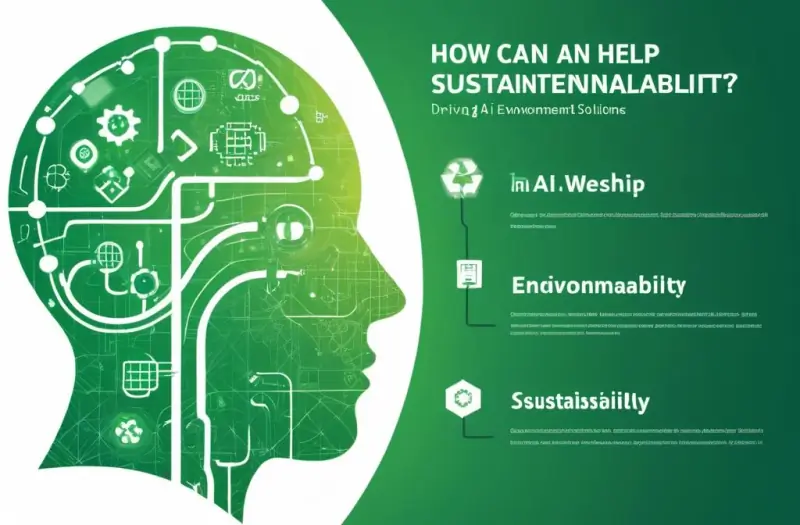How AI Can Drive Sustainability | NZ Guide

Table of Contents
Introduction
As the world faces unprecedented environmental challenges, the need for innovative solutions has never been more pressing. In recent years, artificial intelligence (AI) has emerged as a powerful tool to tackle sustainability issues, from reducing carbon emissions to improving ecosystem health. With advances in machine learning, AI-driven climate solutions have become increasingly accessible, empowering industries, governments, and individuals to make more environmentally conscious choices.
Our approach to AI for environmental sustainability emphasizes harnessing data to drive actionable change. As we dive into how AI can help sustainability, we’ll explore its role across multiple fields—from renewable energy optimization to waste reduction. By understanding the potential of AI, we can better appreciate its place in a sustainable future.
AI for Environmental Monitoring

One of the most impactful uses of AI in sustainability lies in environmental monitoring. Through advanced data analytics, machine learning algorithms can analyze vast amounts of information to detect patterns that indicate environmental risks or changes.
For instance, satellites equipped with AI-driven monitoring systems track changes in land, water, and vegetation over time, providing real-time data to address deforestation, wildfires, and urban expansion. With AI, authorities can respond faster to environmental threats, significantly improving their chances of controlling or preventing ecological damage.
AI is also instrumental in monitoring air and water quality. By utilizing predictive modeling, AI can identify pollution sources and forecast pollution trends, enabling proactive measures to safeguard public health and natural resources. Such eco-friendly AI applications highlight the importance of AI as a crucial component in maintaining ecosystem balance.
- Key benefits of AI-driven environmental monitoring:
- Real-time data on ecological changes
- Proactive pollution management
- Enhanced emergency response for natural disasters
Sustainable AI Practices in Resource Management
Another area where AI plays a pivotal role is in resource management. By optimizing the way we use energy, water, and raw materials, AI-powered sustainability efforts help reduce waste and support conservation goals. Through data-driven sustainability, AI analyzes consumption patterns, identifying areas for improvement in energy efficiency and resource utilization.
For example, intelligent resource conservation systems use AI algorithms to manage water distribution in drought-prone areas. By forecasting water demand and availability, these systems ensure minimal water wastage while meeting agricultural and industrial needs. Similarly, AI is used to optimize power grids, ensuring more efficient energy distribution that aligns with supply and demand.
Smart resource management also applies to the supply chain. By analyzing logistics and manufacturing processes, machine learning for resource management identifies inefficiencies, allowing companies to reduce their environmental footprint.
AI in Renewable Energy Optimization
The transition to renewable energy sources is vital to achieving sustainability, and artificial intelligence in green energy is driving this shift. With AI’s ability to analyze weather data and predict energy production, AI for renewable energy optimization maximizes the potential of resources like solar, wind, and hydro.
Solar and wind farms use AI-based environmental preservation tools to predict output based on weather conditions, ensuring a steady supply. This enables renewable energy companies to reduce reliance on nonrenewable sources and decrease greenhouse gas emissions. Additionally, AI algorithms are instrumental in managing energy storage, ensuring that surplus energy generated by renewables is stored efficiently and released during periods of high demand.
In smart grids, AI controls the balance between electricity supply and demand, effectively integrating renewable sources into the grid. Green technology with AI thus enables a more resilient energy infrastructure, fostering a sustainable future.
Benefits of AI in renewable energy optimization:
- Efficient energy generation from renewable sources
- Reduced dependence on fossil fuels
- Improved energy storage and distribution systems
Smart Agriculture AI for Sustainable Farming

Agriculture plays a significant role in sustainability, and smart agriculture AI has opened up new possibilities for eco-friendly farming practices. By applying AI-powered sustainability efforts in agriculture, farmers can increase productivity while reducing environmental impacts.
Through machine learning and data analytics, AI helps farmers monitor crop health, optimize water usage, and manage fertilizers more efficiently. Precision agriculture, powered by AI in waste reduction, ensures that resources are allocated where they’re needed most, minimizing runoff and soil degradation.
Another example is the use of AI in predicting pest outbreaks. AI systems analyze climate and soil data to forecast conditions that may lead to pest infestations, allowing farmers to take preventive measures and reduce the need for chemical pesticides. These sustainable technology innovations improve crop yields and reduce the ecological footprint of farming.
- AI contributions to sustainable agriculture:
- Precision resource allocation
- Reduced pesticide and fertilizer use
- Improved crop health and yield
AI and Carbon Footprint Reduction
As organizations worldwide aim to reduce their carbon footprint, AI technologies are essential tools in achieving this goal. By using carbon footprint reduction AI, companies can monitor emissions and identify areas for improvement.
AI’s predictive capabilities allow companies to forecast emissions trends and evaluate the impact of operational changes on carbon output. By automating emission tracking, AI enables more accurate carbon reporting, ensuring compliance with environmental regulations. In addition, sustainable AI practices in industries such as manufacturing and logistics optimize operations to reduce energy consumption and waste.
AI can also promote greener transportation by optimizing routes for freight and passenger travel. Through data analysis, AI recommends efficient routes, reducing fuel consumption and emissions in the process. This AI in climate resilience makes a meaningful contribution to global sustainability efforts.
Intelligent Waste Management with AI
Waste management is a critical component of sustainability, and AI’s role in intelligent waste management is transformative. From recycling to waste reduction, AI for environmental sustainability provides insights to improve waste handling practices and foster a circular economy.
AI-driven systems can sort recyclable materials with high accuracy, reducing contamination in recycling streams and increasing the overall recycling rate. Additionally, AI in waste reduction helps companies analyze production waste, enabling them to adjust manufacturing processes to minimize waste generation. With AI, we can better track waste and ensure that it is disposed of responsibly, significantly impacting environmental health.
Ways AI enhances waste management:
- Automated sorting of recyclable materials
- Optimization of waste disposal routes
- Reduction of production waste in manufacturing
FAQs
How does AI contribute to environmental sustainability?
AI contributes by optimizing resource usage, predicting environmental threats, and enabling smarter waste management practices.
Can AI reduce carbon emissions?
Yes, AI helps organizations track and reduce emissions by optimizing energy use, logistics, and resource management.
How does AI support renewable energy?
AI analyzes weather data to forecast renewable energy generation and manage energy storage, helping to integrate renewables into the power grid effectively.
Is AI being used in agriculture for sustainability?
Absolutely, AI supports precision agriculture by optimizing water and fertilizer usage, monitoring crop health, and predicting pest outbreaks.
What are AI-driven climate solutions?
AI-driven climate solutions involve using AI technologies to tackle climate-related issues such as emissions reduction, renewable energy optimization, and environmental monitoring.
Conclusion
AI offers powerful tools to drive sustainability and address pressing environmental challenges. From eco-friendly AI applications to AI-powered sustainability efforts, AI provides valuable insights and innovations for a greener future. By leveraging sustainable technology innovations, we can make informed choices that benefit our planet while enhancing productivity across sectors like energy, agriculture, and waste management. Through AI in waste reduction, AI for renewable energy optimization, and AI-based environmental preservation, we’re taking significant strides toward achieving a sustainable future.
Key Takeaways
- AI enables real-time environmental monitoring, providing data crucial for proactive measures.
- AI in resource management helps optimize energy, water, and material use, reducing waste.
- Renewable energy optimization through AI maximizes resource efficiency and energy storage.
- Smart agriculture AI supports eco-friendly farming, improving crop yields with minimal environmental impact.
- Carbon footprint reduction AI allows organizations to track and lower their emissions effectively.
- AI in waste management promotes responsible disposal and recycling practices, contributing to a circular economy.
Artificial intelligence is not only reshaping technology but also driving meaningful change for a more sustainable world. Together, we can harness the power of AI to create a healthier, more resilient planet.
Popular Tags
ADS SPACE HERE


